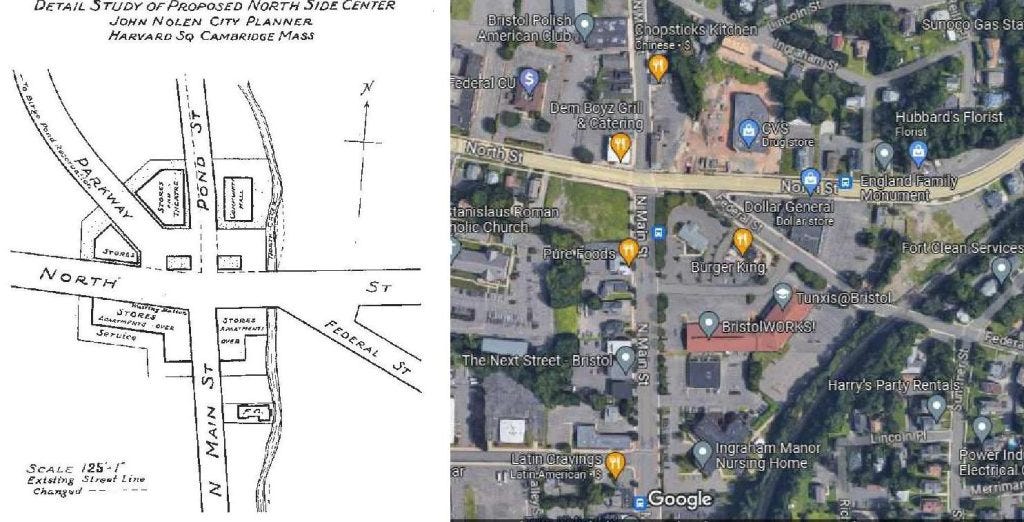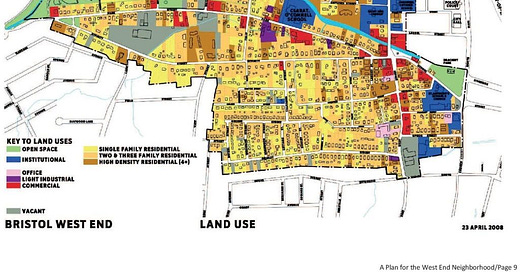1920 Bristol Conn. Planning Proposal by John Nolen
My notes on Germany 1648 to 1806 , Germany 1800 to 1840s , Waikato the golden age 1840s to 1850s , Waikato 1860s , Gentry & Speculators , The beginning of modern planning: Water, Sewage, Housing, Transport, City Centre, Markets and Zoning, 1890s: Introduction, Dwellings & Lots, Reason for Zoning, Horses, Cyclists & road deaths, York, City beautiful & genesis of motorways, Garden City, Dresden 1903, Chicago 1909, 1910s: Hamilton, Columbus, Rochester and Seattle, Newark, Berkeley, Bridgeport, Walpole, Genesis of housing crisis, Hamilton’s 5 leg intersections, 1919 NZ Planning: Urban country, what planning adds & racism, Garden suburbs, rules & Kurralta Park, Root Cause, Cost of renting & Home ownership,
Paragraph notes are from the 1920 Local survey and city planning proposals for Bristol, Connecticut, by John Nolen. Images and captions compare changes over the century.
SHOPPING DISTRICT 1; In 1920, Bristol (1920 population of 20,620, p.16) ‘is in a transitional stage from residences to stores, especially north of Centre Street. Industries occupy part of the frontage on this street, producing breaks in the development to the disadvantage of retail store expansion’ (p.16). This disadvantage can be debated. The Dutch town Raatle (Link) has a pig food factory at its centre, surround by a mix of retail and residential areas. This is not normal, but appears to be manageable and still allows active healthy retail expansion.
Raatle NL. (2017 Population 20,000)

SHOPPING DISTRICT 2; ‘Bristol business suffers from lack of a real shopping district and what is needed is an opportunity to get away from the one street idea and induce business to expand about a given centre instead of along the one or two main streets’ (p.26). Below is the 1920s proposal to induce business to expand from a given centre, alongside 2020 Google maps view of outcome. I think the ‘get away from one street idea’ lacks evidence that it is a real shopping district. Sylvia Park Auckland and Hamilton Base covered shopping mall are based on a one-street idea. Another example is Middelharnis NL (link), which has one street shopping main street with a changing mix of residential and retail.

HOUSING; ‘During the [first world] war Bristol's industries had a period of great expansion, but at the same time the normal development of housing facilities was not maintained and the result was, as in practically all American industrial communities, a housing shortage. To meet these conditions the Bristol Realty Company, New Departure Realty Company, the Bristol Brass Co. and the National Marine Lamp Company started housing projects that have produced a total of approximately 400 houses (mostly two-family houses) and taken care of approximately 750 families. These developments have gone a long way toward relieving the demand for houses, but only for the present’ (p.17).

BLOCKS: ‘Wherever blocks run less than 600 feet [182m] [it also stated ‘less than 64m should not be allowed’] in length they produce an excessive percentage of street area and are therefore not economical ... blocks should not exceed 1000 feet [305m] in length. Such [long] continuous stretches of built-up property are inconvenient, interfere with circulation, produce monotony ...’ (p.39). The Hamilton East blocks, being about 250m long are well sized.
LOT SIZE: ‘wherever possible lot lines should be laid off at right angles to the street line [which is same as New Zealand’s 1875 rule*], or in the case of curved streets, at right angles to the point of tangency. ... The depth of the lots ... even of the lower class should be kept, if possible, to the 120 foot [36m] dimension. The width of the lots will vary with the type of building to be erected, but for all residential purposes the minimum should be at least 40 feet [12m]’ (p.40). The width is in line with New Zealand’s minimum width at the time (Link p.??). The above dimensions from Bristol equate to a 432m2 lot size, which is greater than the ‘337 m2’, which in ‘garden cities of England has shown that an exceedingly high standard of health can be maintained, and convenient dwellings built with attractive surroundings’ (Link p.214).
Plans of Towns Mr. C. O'Neill, M.P. for Thames, Plans of Town Regulation Bill 1875
2021 Youtube - Bristol Connecticut ( Bristol CT.) Drive Thru 4K Travel Videos 36 minutes




